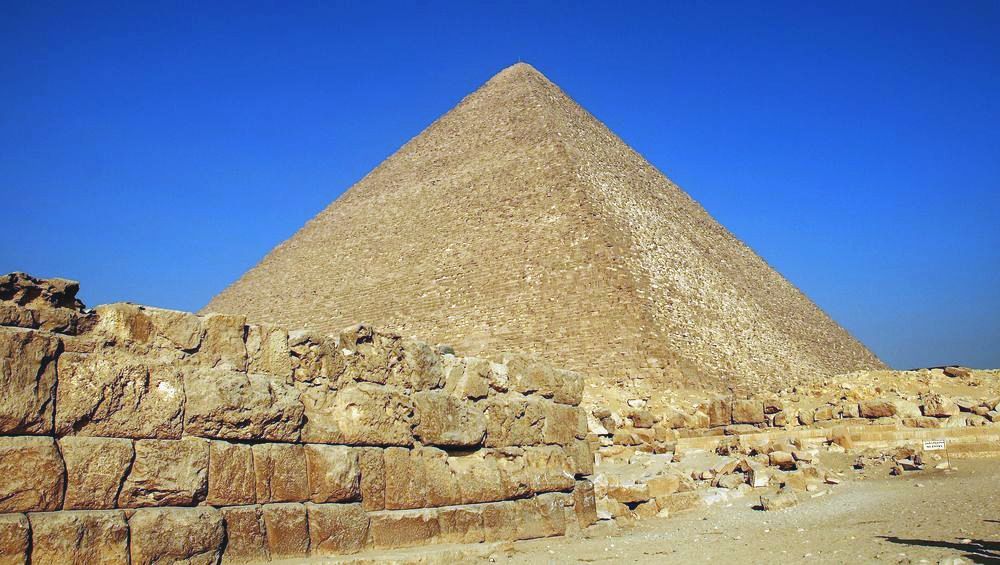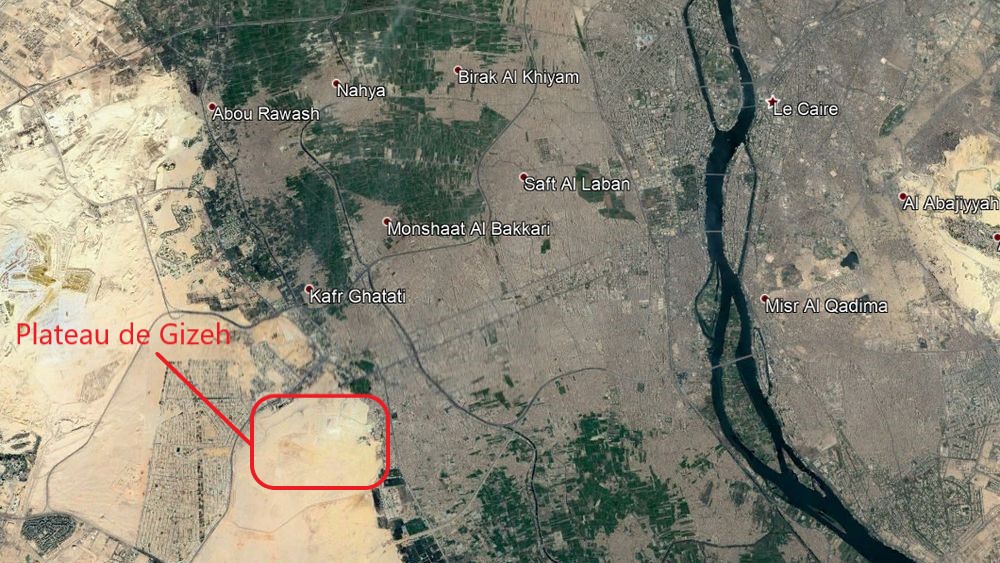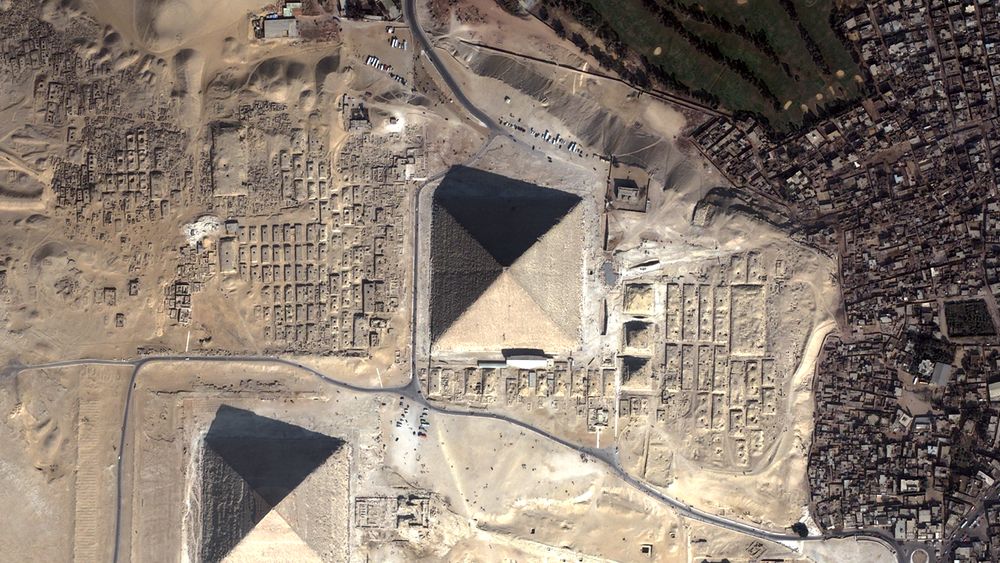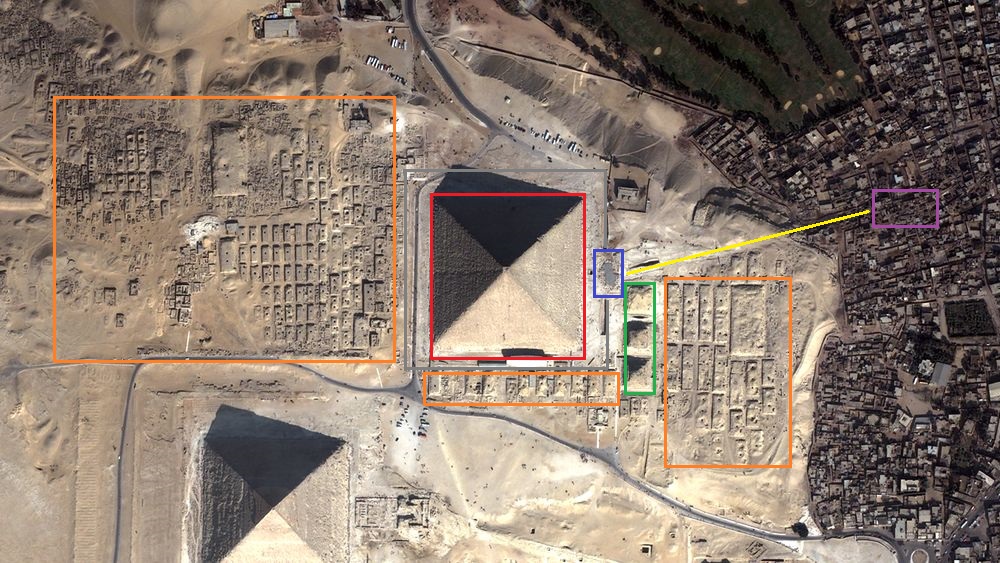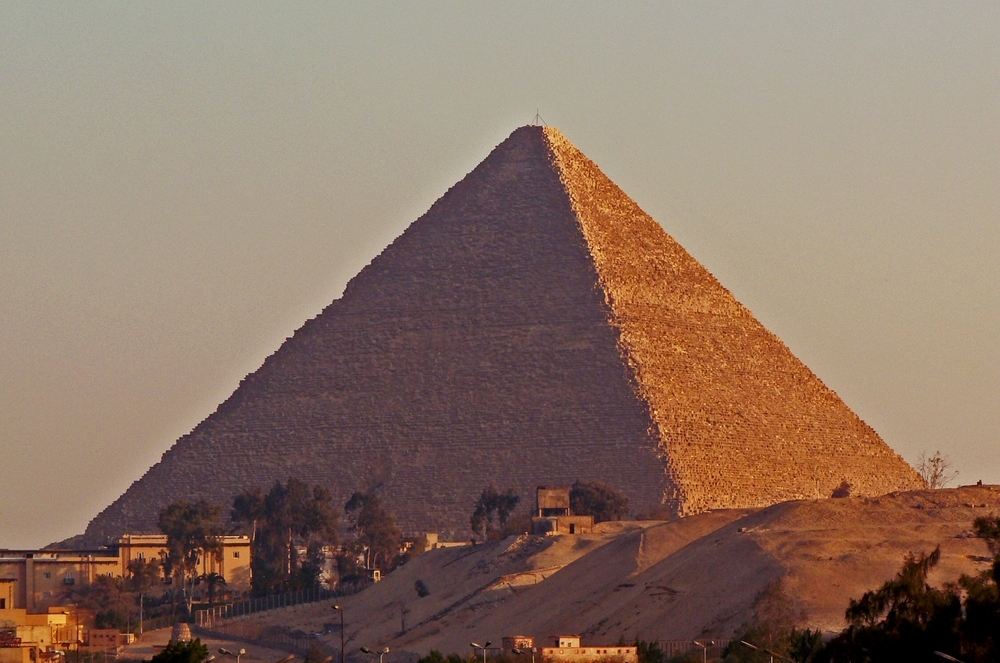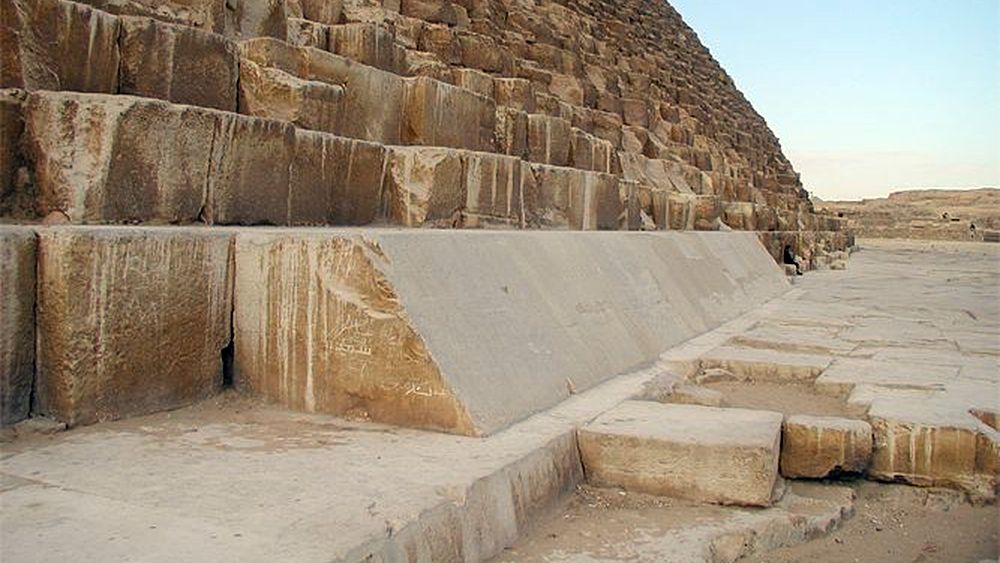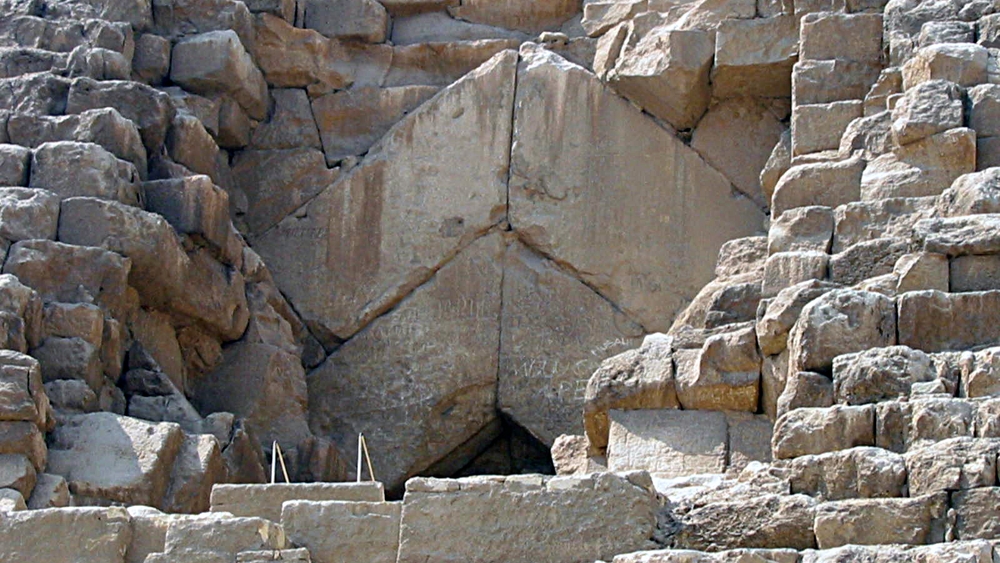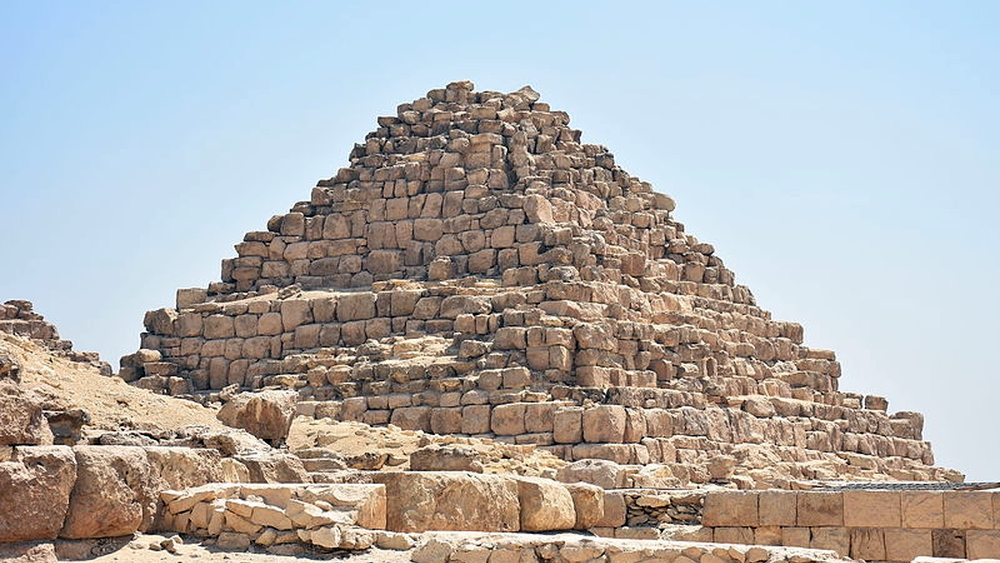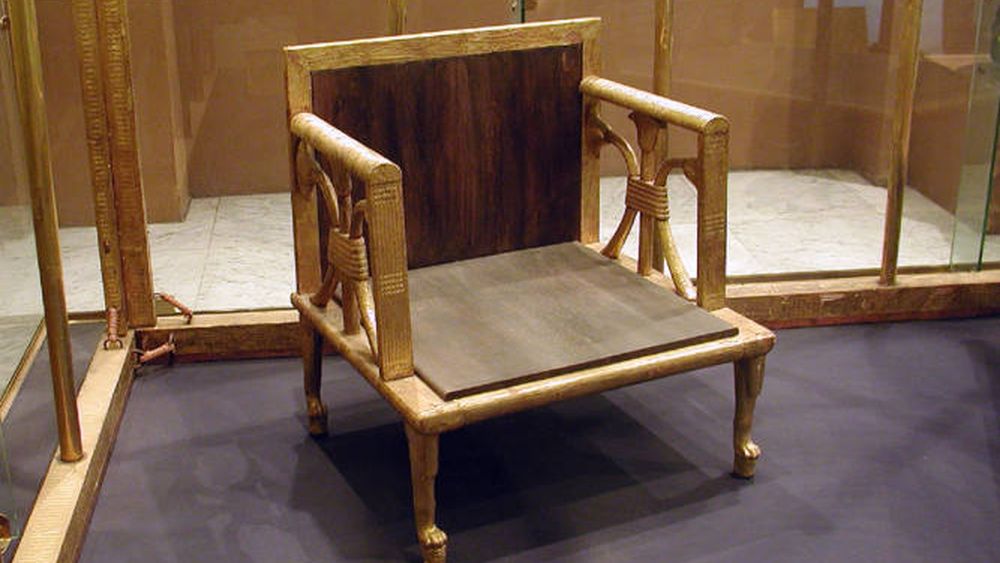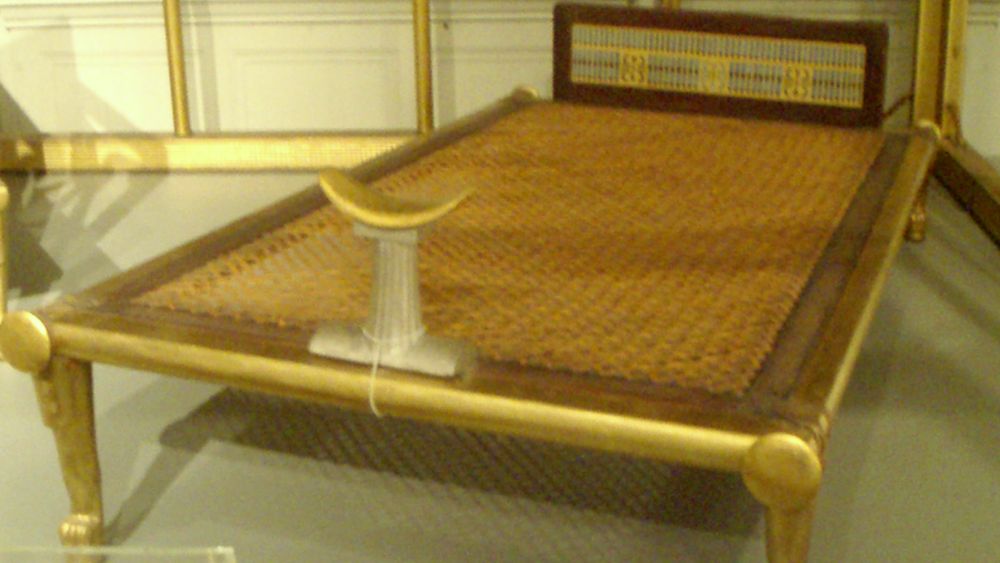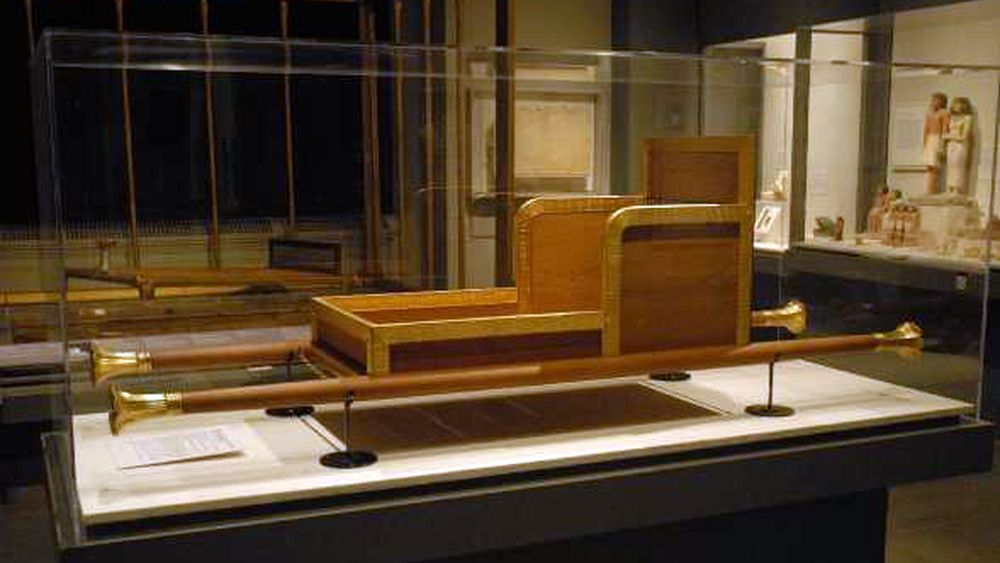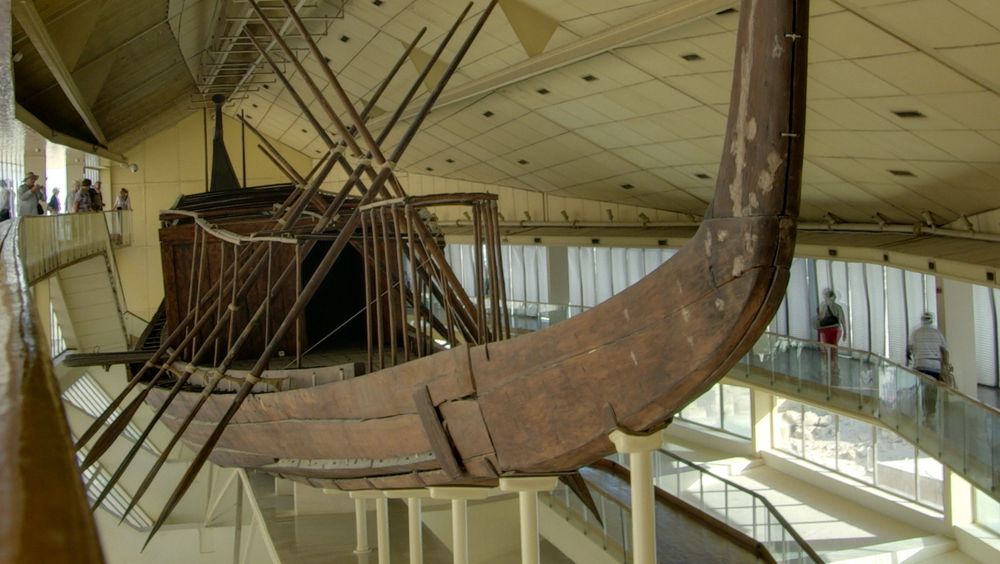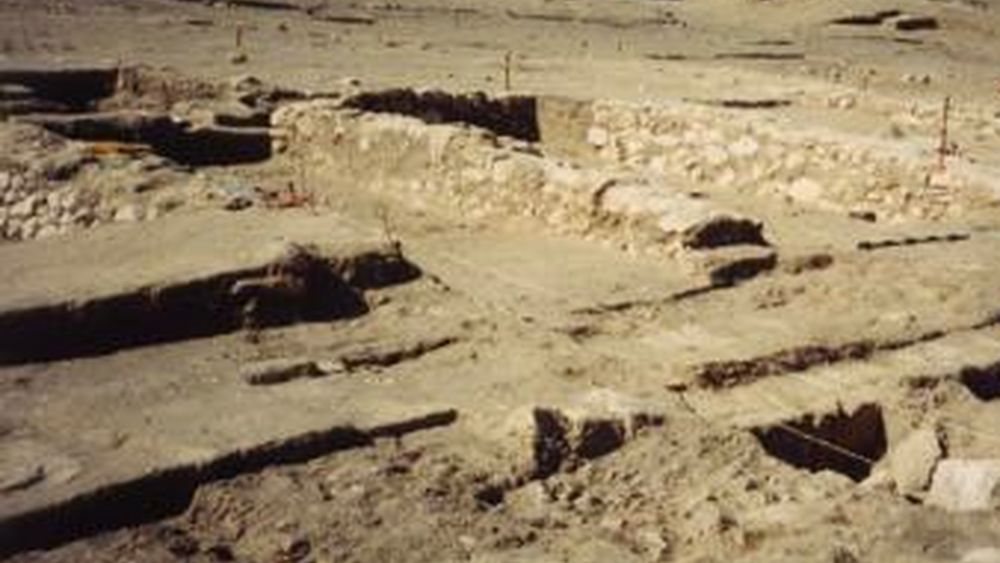The pyramid of Khufu is the highest and most voluminous of all the pyramids of Egypt. Particularly impressive from close up, but of more appreciable proportions by far, it is in a state of conservation quite acceptable if compared with many others in the area, often completely collapsed.
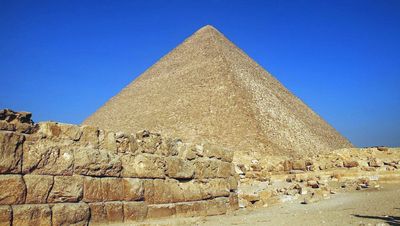
The pyramid of Khufu
It represents the pinnacle in the field of Egyptian monumental architecture. Its construction required skills in this area that have accumulated since the construction of the very first pyramid, that of Djoser, a few decades earlier. Moreover, the pyramid of Khufu is part of the list of seven wonders of the world, and it is the only one of the seven to be still standing today. The fact that it went through not the centuries but the millennia says a lot about the know-how accumulated by the ancient Egyptians in architecture.
The reasons for its construction are obscure to us. We know that this is a tomb intended to receive the mummified body of the pharaoh for eternity and help his soul to continue his journey in the other world, in accordance with the beliefs of ancient Egyptian spirituality. The pyramid shape is also a help to the rising of the soul, the famous "Kâ", towards the Heavens. If the first pyramid was a kind of stairway to Heaven (Djoser's Step Pyramid), the shape quickly turned into a smooth-faced pyramid, more aesthetic but also more difficult to implement.
But the mausoleum of Khufu is not just a pyramid. It is above all a funerary complex of great importance, including various elements whose pyramid is the most impressive. But it is accompanied by a high temple, located just next to the pyramid, a low temple, lower down the valley, a roadway that connects the three buildings, two cemeteries containing the tombs of personalities close to the Pharaoh and four ancillary pyramids (one for each of his wives and a fourth for worship).
Historical context
The pyramid of Khufu was built in 2589 and 2566, these dates may be subject to caution, of course. At that time we are in the ancient Egyptian empire, a long period that begins in the 3rd dynasty, around 2650 BC and goes until the first intermediate period, around 2200 BC. This period is considered the golden age of Egyptian civilization. It was during these years that the Egyptian people united around a strong and respected leader on a perfectly defined territory. The administration developed, which allowed the population to always have close to oneself people who could decide collective actions to be taken for the good of all Egypt, the people did not live anymore in autarchy as it had been the case previously.
The Third dynasty began with Pharaoh Djoser who had a funeral complex built on the plateau of Saqqara. It was initially a simple mastaba whose architect, Imhotep, superimposed another mastaba, smaller. Then, the construction techniques allowing it, he built a real pyramid at 6 degrees high of 62m, a feat for the time but also a height record for an artificial construction. The next two rulers, Sekhemkhet and Khaba, also built step pyramids, but they remained unfinished. There followed several provincial pyramids, a particular name for smaller pyramids (between 12 and 18m high) built in the kingdom's provinces. Then came the first pharaoh of the fourth dynasty, Snefru.
Snefrou had several pyramids built. We do not know if they were parallel or if they followed each other, in a construction order, but still it was that four pyramids were erected during his reign:
- The last provincial pyramid, bigger than the others (25m in height),
- A pyramid with a smooth face, but whose construction was failed (in Meïdoum)
- The rhomboid pyramid, which is a smooth-faced pyramid with a change of slope (in Dahshur),
- The red pyramid, the first successful smooth-faced pyramid.
Snefrou's son, a certain Khufu, took full advantage of the construction techniques of his predecessors.
Learn more about the History of Ancient Egypt.
Geographic location
Geographically, the Khufu pyramid is located on the plateau of Giza, a few kilometers west of the Nile and about 20 from the center of Cairo. This plateau overlooks the Nile Valley and nowadays the agglomeration of Cairo whose last buildings adjoin the archaeological site of Giza. We are at the foot of the Nile Delta, in an arid region.
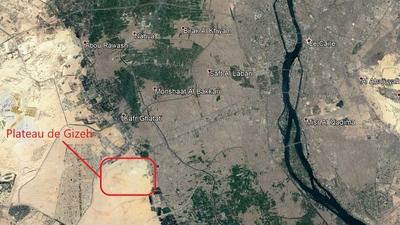
Location of the pyramids of Giza
Learn more about the location of the plateau of Giza.
Who was Khufu?
Khufu is the name of the second pharaoh of the IVth Dynasty in ancient Egypt, he lived in the twenty-first century BC. His reign is essentially characterized by economic development based on increased mining of copper and turquoise mines (Sinai, Nubia) and diorite mines (Abu Simbel). If it is difficult to trace history precisely, the imposing constructions left by Khufu seem to indicate a certain stability in the kingdom, which is confirmed by the discovery, around the Mediterranean, of hieroglyphs in the name of Khufu . These discoveries prove the presence of representatives, probably traders, in strongholds far from Egypt, proving the ability of the Egyptians of the time to move.
Learn more about the life of Khufu.
Who was the architect?
Of course, it is not Pharaoh himself who followed the work of his funeral complex. He chooses a man of trust, a close friend (he was a cousin), the architect Hémiounou
Hémiounou was also a confidant for the pharaoh, he had a role of adviser. To prove its importance at the time, it is sufficient to know that his grave was in the western cemetery of the funeral complex, and that it was particularly impressive. The size of the tomb and its location was directly proportional to the interest the pharaoh had in the person.
Learn more about vie d'Hémiounou.
The funeral complex of Khufu
The Khufu funeral complex is composed of several elements including the pyramid which is the center of it.
- The pyramid itself
- The high temple
- The low temple
- The roadway
- The annex pyramids
- East and West Cemeteries
- The solar boat
All these elements are to be completed with the buildings common to the three pyramids of the necropolis of Giza, namely the two pyramids of Khafra and Menkaure: The village of workers, which is an archaeological site that allowed the release of the city where the builders of the pyramids lived.
Resort plan
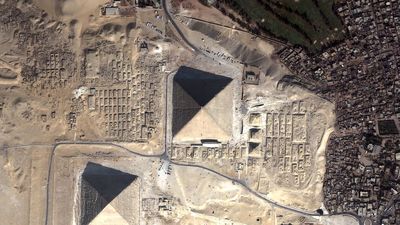
Aerial view of the pyramid of Khufu (click to enlarge)
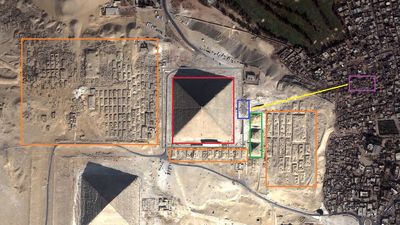
Same annotated view (click to enlarge)
The plan of the Khufu complex is radically different from that of the very first pyramid, that of Djoser. As much as the latter was made up of a set enclosed in a rectangular wall inside which were drawn two courtyards lined with several functional buildings and worship, as that of Khufu is open on the plateau.
The pyramid (in red) is the central point. Along the east side is the tall temple (in blue). An access road (in yellow), probably covered, connected this temple to a temple that is called the "temple of the valley", or "low temple" (in purple), more to East and a little more to North. This low temple had a wharf, it skirted a kind of artificial harbor created on a Nile arm today disappeared. It is strange to think so, but 4500 years ago the region was not as dry as it is, it was rather a hot and dry climate that allowed the development of a savannah. The vegetation was therefore quite different, the terrain also since the Nile came so far, hence the possibility of having a dock.
The pyramid was surrounded by a high wall whose traces we still have today. Passing 24m from the pyramid except South side, where it was only 5m, it is represented in gray on the annotated plan. East side are also the 3 pyramids annexes (in green), more, in the South-East but nowadays destroyed, the small pyramid of worship.
Remains, in the plan, of the two large cemeteries (in orange), one in the East, the other in the West of the pyramid. It is admitted that the mastabas of the south of the pyramid are part of the eastern cemetery. The size of the tombs and their proximities of the pyramid is directly proportional to the power of the person during his life. The closer we were, the bigger the grave, the greater our role with the pharaoh.
The spiritual function of such a set is that in Egyptian worship the soul of everything is part of a whole. In being born the person draws in spite of herself a part of Ka, as he called it, and at his death he returned to the Ka. To be able to return to the primordial ocean, the one where everything is born, you need a boat, a dock, a port: That's the role of all these installations.
The Solar boat is a material element, proof of the mixture that ancient Egyptians made between the spiritual and the real: It was really built and buried at the foot of the pyramid, about fifteen meters from the North face, in a large pit. Explored, this pit showed us a magnificent boat whose role was to allow the pharaoh to go up the river to the primordial ocean once dead.
The pyramid
The Khufu pyramid is unique in the world in its size of course, but not only. It has features that make it unique in many ways.
First, there is no alignment of the three burial chambers, unlike other pyramids. Similarly the master bedroom is not in the ground but inside the monument, which is rather unusual. These are two quirks of this pyramid.
Dimensions
Its dimensions are impressive: 146.60m high for a square base of 230m, each side has a difference of 20cm only. Even the horizontality is close to perfection since there is a difference of only 21 mm from one point to another of the base. As for the height of 146.60m, it corresponds to the height at the creation of the pyramid, nowadays it is only 138m. The orientation is also interesting to know: The four faces of the pyramid are oriented on the cardinal points with a difference of 3'54 '' only. As for its slope, it is 50 ° 52 '.
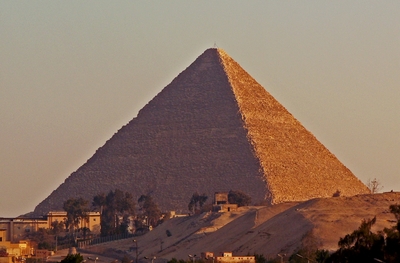
Superstructure
There remains an original curiosity, specific to this pyramid: The apothem phenomenon, which consists in having a slight line of separation on the heights of the 4 faces, with a hollow following the face which cuts it in two. The hollow being only 27 ', it is invisible to the naked eye, but in grazing light, the phenomenon is highlighted.
Learn more about apothem phenomenon.
Learn more about dimensions of the pyramid of Khufu.
Superstructure
The superstructure is the massif of the pyramid itself. It is made of limestone blocks of variable size, the size being identical to each layer. Thus, the higher the height, the lower the height of the blocks, before increasing a little higher, then reduce again, all forming 18 cycles out of a total of 201 rows. This is a rather strange construction, because generally, there is proportionality between the height of the building blocks and the altitude taken: The higher you go, the smaller the blocks. Well not to the pyramid of Khufu, which has a fluctuation of the height of the blocks constituting it variable per cycle.
We do not know why it was built that way. Perhaps it was because the quarries from which the stones were quarried were streaked with fracture lines, which naturally precut the blocks to a given size. This size being variable, the blocks of stone extracted were too. Still, the pyramid uses about 2.3 million blocks of stone for a total weight of 5 million tonnes ... which is a lot.
The pyramid has on a stop a notch on the Northeast corner. It is 3m66 high and 3m66 wide, but its function is unknown. It is also not known whether this is a peculiarity desired by the builders of the pyramid or whether it was made after the fact, a little, for example, to serve as an observation post. What is certain is that it already existed at the beginning of the 19th century.
Another peculiarity of the Egyptian pyramids, they were most often finished by a pyramidion which, as the name suggests, was a small monobloc pyramid ending the summit. Generally richly decorated, they have sometimes been found on archaeological sites, but it is not really common. That of the great pyramid of Khufu has been lost, we do not know.
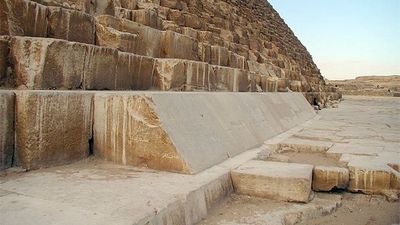
Rest of the siding
Thecoating of the Khufu pyramid is almost completely destroyed. There are still small pieces at its base, in places. It is polished limestone block, perfectly adjusted to each other, which covered the entire pyramid, making it almost white. This is a fact that is hard to imagine today, but so were most of the ancient pyramids of Egypt, all covered with white limestone. The pyramid of Khafra, it retains part of its coating, at the top, and the rhomboid pyramid has almost all its coating, it is the pyramid that has the most nowadays. The paving stones come from Tourah, a site known for having in its basement many underground quarries of fine limestone used to build the pavement of the pyramids.
Learn more about the origin of stones.
Internal structure
The pyramid of Khufu has two entries, an original, mouthful, and an artificial, dug in 820 AD.
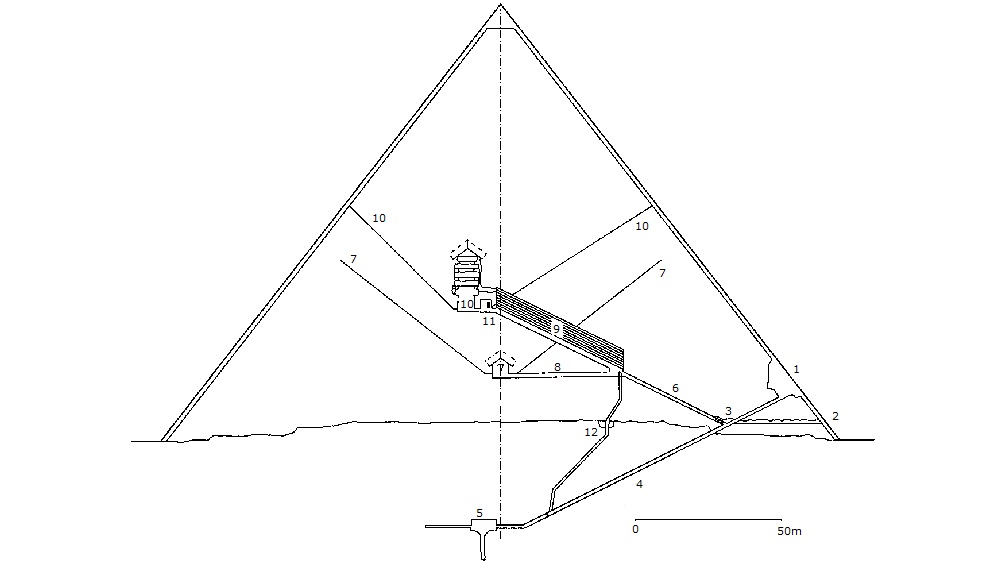
The original entrance (1) is 15.63m high, on the 13th degree, in the center of the North face. It is protected by two huge lintels arranged in chevrons to distribute the load supported by the entrance on the sides and thus to protect the access.
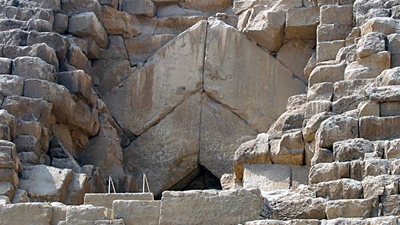
Entrance to the pyramid of Khufu
The second door is the current entrance (2) of the pyramid. It is an artificial opening created by the workmen of Caliph Al-Marmoun in 820 AD. Curious to know what the pyramid contains, and especially eager to recover its potential riches, the caliph ordered a breakthrough in the hope of reaching a clean room. The Caliph's Gallery (3) is 1.20m high and 1m wide and is downhill on 105m (4). At about 20m from the entrance a hole in the ceiling leads to an ascending gallery. At the end of the downhill gallery joins a corridor of 9m which arrives on an unfinished room of 14 x 8m, on 3m50 high. This chamber (5) has a well that was once 3m deep and a hose 0.76m wide by 0.73m high, so very narrow, over a length of 16,50m. It is a cul-de-sac that leaves from the south wall of the room.
The Rising gallery (6), which starts from the ceiling of the excavated gallery, measures 39m long for a space equivalent to the Caliph's gallery, but is blocked by 3 heavy blocks of granite. The end of this gallery arrives at the entrance of the large gallery (9), a communication node internal to the pyramid. Indeed, from the entrance to the large gallery, you can either go up this large gallery, or take another gallery (8) which goes horizontally to the "Queen's room", or go down through the "gallery of thieves". This gallery of thieves (12), improperly named, is a narrow casing that descends almost vertically in the pyramid to end, via a small room, in the gallery of the caliph, just 8m from its end. This gallery of robbers do not seem to have been dug during construction because it pierces the masonry of the pyramid before being dug into the limestone rock of the plateau of Giza.
Starting from the "node", at the bottom of the large gallery, it is possible to follow a horizontal gallery (8) of 1m wide by 1.10 to 1.70m high (more we approach the end, the higher the height). It leads, after 32m20 of gallery, to the room of the Queen (7). Here too this name is clearly usurped, it is a name given by the first explorers who were not yet aware that no queen was buried in the monument, their tombs were outside, in the three small pyramids annexes. It could come from the Arab era where, it seems, the tombs of wives had a two-sided roof similar to the relief stones of the ceiling of the Queen's chamber. This room is quite small, it measures 5m70 x 5m20 on 6m70 high. It lies on the axis of symmetry of the pyramid, oriented East-West. This room is simple, it has a niche of 4m60 by 1m50 wide and 1m deep, but its current depth is 6m because it was dug by looters to try to find a new gallery behind. The Queen's room is also equipped with two ducts that are called "air ducts" but which could rather have a spiritual rather than functional role, starting from the North and South sides, horizontally over 2m and at an angle of 39 ° then to open in the open air, on the north and south faces of the pyramid. These ducts are 65m long and lead to two slabs with metal handles. Nowadays, these conduits are blocked by iron bars, one by conduit, during the twentieth century.
The Large Gallery (9) is the central piece of the pyramid, from which several galleries leave. It measures 47m long and 8m high, its ceiling is corbelled and it is equipped, over its entire length, a seat 50cm high by 60 wide and pierced every 1m40 of rectangular holes.
The high end of the large gallery leads to an antechamber (11), then a room called the king's room. The antechamber measures 1m30 on 1m20 for 1m10 of ceiling, it is really a very small room where it is necessary to enter curved. It is granite and its end opens on a second antechamber of the same dimension with the exception of the width, which is 2m40. It is the exit of this second antechamber that one arrives on the room of the king (10), there also an arbitrary appelation. This room is all in granite, it measures 10m50 x 5m20 and its ceiling rises to 5m80. What is striking, architecturally speaking, is that the ceiling is fivefold: There are five ceilings one above the other, the highest being arranged in chevron to distribute the weight of the pyramid on the outside of the room. Each ceiling being separated from the next by a space, five small chambers of discharge are formed above the king's room. It is in the last, the highest, that we found the only inscription of the whole pyramid, and of course, it is the cartouche of Pharaoh Khufu. It is this unique indication that makes specialists say that this pyramid is attributed to Khufu. The bottom of the king's chamber houses the granite sarcophagus of Khufu, and it has the same "air ducts" as the Queen's room. These ducts, which could have only a spiritual role are square and measure 20cm of side. The South pipe climbs to the open at an angle of 45 ° and the north 32 °.
Air ducts (7 and 10) would have a religious rather than a functional role. Two facts seem to prove this hypothesis. First of all, the ducts were blocked before the intervention of the "modern" archaeologists, then, the orientation of the ducts makes that they point all four towards particular stars, visible in the sky, at a time accurate of the year. But this could just as well be a coincidence, and the function of these conduits could be more religious, it would be an opening for the deceased's K to escape freely, for example. A strangeness since the Ka is supposed to descend to the river via the solar boat, buried at the foot of the pyramid. These narrow corridors have not yet delivered their secrets.
fortified enclosure
It is difficult to imagine today, but the pyramid was surrounded by a high wall of protection serving as much spiritual separation as temporal. It measured about ten meters high and passed 24m from the pyramid on its faces East, North and West and only 5m along the South face. The tall temple was leaning against its east side.
The secondary pyramids
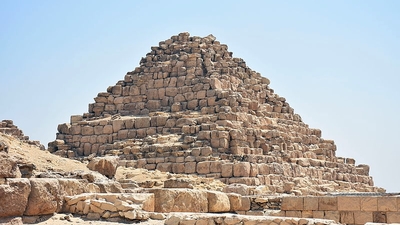
Pyramid of Hétépherès
There are four secondary pyramids in the Khufu burial complex. Three are the pyramids of the queens of Khufu are those located on the east side, and the fourth is a simple religious pyramid, it is southeast of the pyramid of Khufu.
The three queen pyramids are almost identical, they measured 30m20, 30m00 and 29m60 for a square base of 49m50, 49m and 46m. Their slopes are almost identical too, it is 52°. They are named according to an internationally recognized code, they carry the numbers G1a, G1b and G1c. Each of the three has the same internal structure as its neighbor, with an entrance, a gallery leading to an antechamber behind which opens the burial chamber. In addition to the pyramid itself, each had a temple on their east sides. They were all surrounded by a high wall that passed into the temple, the latter then acting as a gateway into the sanctuary. The first two pyramids have a pit for a boat, along their southern sides.
These pyramids are not awarded permanently because they have no inscription, and nothing allows to know who they contained. However, it is assumed that, from North to South, they are a:
- Mérititès
- Heterpheres Ist
- Henutsen
Nowadays these three pyramids are strongly degraded. There remain only the first degrees, or they are complete but have lost their limestone pavements. Because we ignore it today, but the pyramids annexes were also smooth faces. If at present they seem to be at degrees, it is because they have lost this white coating. It is the pyramid G1c which is by far the best preserved, and it is also the one that has never been completed: One can still see on its flanks traces of construction, proving that it has not been completed.
The furniture of Queen Heterispheres Ist
One of the most beautiful discoveries of the Giza Plateau of the early twentieth century occurred in 1925, during George A. Reisner's explorations. Having discovered a block of plaster buried where the rock was expected, the archaeologists of the time cleared a tomb entrance. It led to a well of about 30m deep at the bottom of which was a modest sized room: 5m x 2.5m by 2m high. His interest is that it contained an empty sarcophagus engraved with the name of Queen Heterpheres I, a canopic vase containing the viscera of the queen (or supposed to have belonged to it) and some gold-covered wooden furniture in relatively good condition compared to the fact that they have been locked up here since the twenty-first century BC.
Their extractions were exemplary, and it was quite easy to reconstruct them. They are presented today at the Egyptian Museum in Cairo. If we speak especially of this furniture, it is because it is really exceptional because not only it could be restored to its original state, and so it shows what should be the royal furniture of the old empire but it is very beautiful to see.
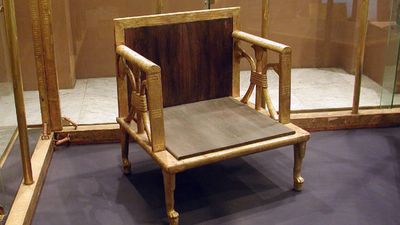
Chair of Hétépherès
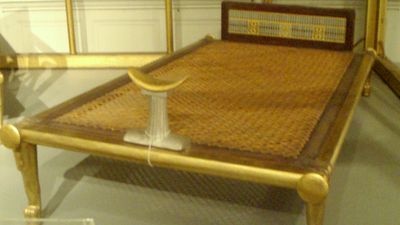
Bed of Hétépherès
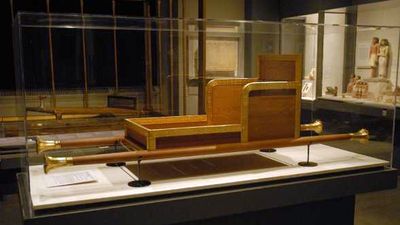
Chair to porter of Hétépherès
The religious pyramid
The fourth pyramid was discovered in 1980, it was never found role. It is thought to be a cult pyramid. It is smaller than the first three, measuring only 13m80 for a low of 21m70 and a slope of 52 ° also.
The temple high
The high temple was a large structure backed by the pyramid of Khufu, on its east side. This is the side facing the Nile, knowing that the latter had an arm that reached the feet of the lower temple, less than 500m away.
Its purpose
His role was to maintain a permanent worship towards Pharaoh. More exactly, there were daily ceremonies, three to be exact (in the morning, in the middle of the day and in the evening) intended to present offerings to Khufu. The number of officiant and the duration during which these ceremonies took place is a good indicator of the pharaoh's popularity. It should be known that the pharaohs being considered as living Gods, to their dead they were naturally the object of an intensive religious cult. At his death the number of devotees devolving Khufu varied. At the beginning it had 10, then, during the 5th Dynasty this number increased until it reached more than 60 during the 6th dynasty. This is a very high number for a pharaoh who reigned so long before, but whose impressive pyramid at Giza was probably a help in maintaining his memory. The cult of Khufu therefore known an increase of the faithful during the old empire, before the first intermediate period put an end to it. The middle empire forgets Khufu, and it will be necessary to wait for the new empire so that one finds the worship of Khufu within the ancient Egyptian society. At this moment, we find traces of the God Khufu with that of Isis, as if the two were linked.
Its architecture
It measured 52m50 in the North-South axis and 39m60 in the East-West axis, but nowadays it is completely destroyed, leaving us only a few ruins showing the bases of its internal layout. The temple was composed of an inner courtyard of 46m00 x 26m70 paved with large slabs of basalt. It was surrounded by colonnades as was often the case at the time. There were 34 of them, in granite, distributed as follows:
- A colonnade of 12 pillars in the East
- A colonnade of 12 pillars in the West
- A colonnade of 5 pillars in the North
- A colonnade of 5 pillars in the south
To this must be added four independent pillars that supported the corners of the courtyard. In the building there were two rooms open on the courtyard to the west. The first was the largest, it measured 27m long. His ceiling was now by eight pillars. The second room was smaller, it was at the bottom of the first. Measuring only 14m, she had four pillars. The temple had only one entrance, it was the one coming from the roadway.
The temple seems to have been decorated with bas-reliefs. Although it is in ruins today, the Egyptologist Selim Hassan discovered in what was once the northwest corner of the courtyard a partially obliterated bas-relief. The fact that the pavement is decorated with bas-reliefs suggests that it was the whole temple that was, especially since the rhomboidal pyramid also had a fully decorated high temple.
There is still a curiosity to note in the high temple, it is the presence of a small pipe under the temple. It allowed flowing liquids used during the services. Major technological innovation, it was simply a small sewer, an invention made in Europe 4200 years later ...
The pavement
The so-called pavement is probably a covered path connecting the temple high to the low temple. It is 660m long, but nowadays only the first 80 meters are still visible. Curiously its layout is not rectilinear, contrary to what was usually done.
Architecturally the roadway was built of rich local limestone richly decorated, on their internal faces of course. Some of these blocks have been reused, which has allowed us to keep them until today.
The low temple or temple of the valley
The bouy of the pavement reached the lower temple, often called the temple of the valley. It is a second temple, starting point of the Pharaoh's Kâ € ™ s died according to the ancient Egyptian belief. This temple was also ... a dock.
In fact, according to the beliefs of the time, Pharaoh's ka was supposed to join the primordial ocean. For that, he had to use a boat and go down the big river, hence the need to have a dock, but also a boat, as explained below. Boat and temple of the valley are two real elements, they were actually constructed while they were purely spiritual elements. The temple of the valley has now disappeared, it was on the site of the current village of Nazlet El-Samman, 600m east of the pyramid of Khufu. City planning has erased archaeological evidence, but growing interest in modern archeology has meant that excavations have been possible whenever possible. In this way, some remains were found during various works, particularly road works. Part of the temple and port facilities have been identified.
So we know almost nothing of this low temple, alas.
Pits and solar boats
To be able to make its way to the primordial ocean, the deceased pharaoh had to use a boat. Far from being imaginary, two real boats were built and buried close to the pyramid. Found in an impeccable state of preservation, one is exhibited in a museum dedicated to him, just at the foot of the pyramid, the other will be in the future Egyptian museum of Giza.
By clearing the approaches to the Khufu pyramid from the sand gangue that surrounded it in 1954, the workers discovered two areas of the ground covered with thick, heavy slabs and seeming to close two underground chambers. These two areas were long and narrow and were on either side of the temple, along the east face. Another similar area was found along the north face. The archaeologists of 1954 were able to clear the forty slabs that closed the entrance and opened a pit containing a beautiful boat in a very good state of conservation. The second pit was only opened in 1987, after it was discovered that it was no longer waterproof and so that potentially, its contents could deteriorate quickly. There too, the archaeologists (a Japanese team) discovered another boat, also in a good state.
The role of these boats seems clear nowadays: They were to serve the soul of the pharaoh, the Ka, to travel along the Nile to reach the primordial ocean, from which everything was born and where returns all thing.
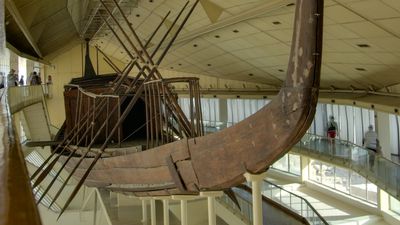
Khufu solar boat
The boat of 1954
It is a wooden boat 43m50 by 6m wide and a draft of 1m50, found in pieces in the pit. It is the Egyptian Ahmed Youssef Moustafa, restaurateur of the Egyptian museum of Cairo, who was in charge of reconstructing the puzzle, a task that took him 10 years.
The boat is made up of 1224 different pieces, some of which are marked with assembly instructions, which has simplified the reconstruction work. The boat has ten oars, so she needed five people to move it forward, plus a helmsman who was standing in the back and maneuvering a pair of rowing oars. In the center was a 9m long cabin, completely closed apart from two doors opening, one forward, the other rearward. At the tip of the ship was an awning that allowed shelter from the sun. The boat was decorated with two magnificent papyrus leaves as a figurehead and stern. The set was made from cedar wood and acacia.
This boat is now visible, whole, in the museum dedicated to it. It is a large room located just above the pit where it was built, and it is the only modern building that exists in the immediate vicinity of the pyramid. Its clean design and its color, identical to the pyramid, make it a building that fits well into the landscape.
The boat of 1987
The second pit was closed until 1987 when a team of Japanese scientists proved that it also contained a boat. But the competent authorities decided not to open it, because doing so might cause damage. It must be said that this pit was sealed for 4500 years, it was not urgent to open it. But the Japanese team proved that the seal had been lost anyway, so the Egyptian authorities gave their agreement to the extraction of the boat, after lifting the forty heavy stones that blocked the ceiling.
The extraction of the various pieces found began in 2013, there are 1200 pieces. When the assembly work is finished, this second boat will be exhibited in the future great museum of Giza.
Learn more about solar boats of Khufu.
Cemeteries
Beliefs in the afterlife
Before describing the two cemeteries that surround the pyramid of Khufu, we must know that during the ancient Egyptian empire the belief in the continuity of life after death was solid. Indeed, the ancient Egyptians thought that what we could call the soul of a person, his Ka for the ancient Egyptians, was a part of a whole and that he returned, after death, in the original ocean where does everything go from.
But during the first dynasties and until the fourth, that of Pharaoh Khufu, only the sovereign could access the other world, the others could only hope to reach the Douat, a common place of life after death. To reach him, he had no choice but to trust the dead Pharaoh who could reach the other world and thus get his people into the Douat. This belief adds a link of subordination between the Pharaoh and his people during the period of life, since in case of failure to the Pharaoh the latter had the power to prevent the Kâ of the offender to join the Douat. This explains why we had to be buried as close as possible to the Pharaoh: The closer we were, the easier it was to cross the world of death.
This belief was harmed from the 5th and 6th dynasties, and especially during the first intermediate period. It must be said that with the Egyptian civilization developing, the pharaoh sent more and more people to provinces to ensure that the local administration executes well the requests of Pharaoh. Suddenly, these loved ones were buried away from their leader ... It was then necessary to invent a spirituality that allows this distance, hence the gradual loss of this belief.
Cemeteries
The Khufu funeral complex has two cemeteries, one in the east and the other in the west.
That of the East was reserved for the queens and very close to the pharaoh, that of the West to the other members of the family and the high ranking officials. Both are organized as modern cemeteries, with wide aisles arranged orthogonally and tombs perfectly aligned.
The East cemetery begins with the three queen pyramids, these are the closest tombs to the Great Pyramid. In their East we find 12 mastabas of importance classified in 3 rows of 4. Originally planned to accommodate one person, they were enlarged towards the end of the reign of Khufu: The 8 mastabas of the North were brought together in pairs, and the 4 South were enlarged, forming a group of eight mastabas that can still be seen today. It was also at that time that they were decorated and equipped with chapels.
The West Cemetery is larger, but its graves are much smaller. It is mastabas shaped truncated pyramids whose walls are not specially worked. Remember that a mastaba is a large solid mass pierced by a masonry chimney from the roof to the burial chamber dug under the rock, a duct plugged at the death of the owner and positioned rather on the northern part of the mastaba. Generally the burial chamber is blocked by a metal grid. The mastaba also contains a chapel built of adobe and opening onto a long and narrow room. The entrance to the chapel has a richly decorated and colorful stele affixed to the south face, it served the worship of the deceased.
There are two much larger graves than the others in the West cemetery, and one in the East cemetery. The first is at Hémiounou, member of the royal family and especially builder of the pyramid of Khufu. He was the architect, the supervisor and the conductor of the works. The other tomb is not yet attributed, we do not know who rests on it. When the East cemetery belonged to Ankhaf, a personality who participated in the construction of the Great Pyramid.
The longer the time has passed, the more the mastabas have been changed, which breaks this impression of uniformity. For example, some families transformed the stele into a false door, others destroyed the adobe chapel and replaced it with another stone chapel, while others finally enlarged the mastaba (from the south, always). The internal structure was also modified, with the addition, sometimes, of the chapel inside the massif itself, even with the construction of a Serdab. A serdab was a small room overlooking the chapel and containing a statue of the deceased. A small hole was dug between the chapel and the Serdab, which was a completely closed room, to allow the deceased to see the worship that was practiced in the chapel through the eyes of the statue. This tradition already existed during the Third Dynasty, the pyramid of Djoser had two.
Construction
It is easy to imagine, the construction of such a monument was not made easily or quickly. Although period documents rarely evoke construction, the archaeological material recovered since the first excavations were launched makes it possible to know a little more about the organization of the site.
Duration
First of all, the pyramid was built in the first years of the reign of Khufu, around 2560 BC. The project lasted a little more than 20 years, the specialists do not necessarily agree, and the documents are sometimes contradictory, but the range going from 23 to 25 years seems reasonable. According to logic and as the few documents suggest, it took 6 years to set up the site, clear the ground, and make the most important calculations, especially those to include the natural hill in the massif, to avoid the manufacture of a large number of stones. The following 10 years were used for the construction of the pyramid, as well as the underground galleries, the high and low temples. The last 4 years were used to complete the work, dismantle the ramps, destroy the temporary constructions, etc.
It must be said that the Pharaoh in ancient Egypt was considered a God, the only person in the world to have the ability to allow his people to access the Hereafter. The construction of a tomb was therefore the major concern of all the people who would allow his pharaoh to leave in good conditions, if only for their property.
Workers organization
The site was organized around a hierarchical structure almost military. The pharaoh, the main interested, gave his orders to senior officials who transmitted them to the architects in charge of the site. They passed them on to the site managers and then to the foremen who did the work. Of course, each hierarchical level could take its own initiatives, in view of its possibilities.
The workers, at the bottom end of the scale, accounted for a quarter of the skilled craftsmen and for three-quarters of the local peasants who were employed when the Nile floods prevented work in the fields. The craftsmen had the tasks requiring some know-how, such as the size of the stone blocks, the leveling of the ground or the construction of construction equipment. Unskilled workers were used to forcing tasks, handling blocks and pulling them to their places.
All the workers were organized in teams of 2,000 people for a total of 20,000 employees on the site of the pyramid of Khufu. This figure is of course an estimate, but it is considered acceptable given the duration of the work and the work to be done. Teams of 2000 employees were divided into two groups of 1,000, each group divided into phylons of 200, each grouped in groups of 20. These twenty employees were the base unit of the site group.
Learn more about the construction of the Pyramids of the Giza Plateau, and more generally on the construction of the pyramids of Egypt.
The village of workers
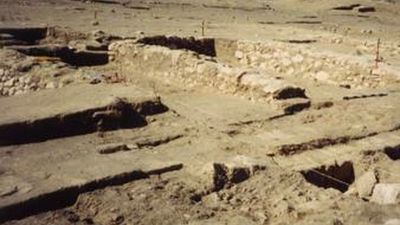
The village of workers
To be able to work on the site, it was necessary to house and feed the employees. It was the role of the village workers, also called "city workers". It is a city 500m east of the pyramid, south of the quays of the lower temple. This place was separated from the rest of the construction site by a high wall and sheltered the population of workers with all that was necessary for their lives there: Bakery, blacksmith (or rather, craftsmen working copper), doctor, etc. This village was recently discovered and has been the subject of studies proving that they were free, well-nourished workers. It seems that only the artisans were housed in this working-class city. The peasants, passing through the building site, were instead housed in canvas camps at the foot of the pyramid.
However it is possible that this place was built after the construction of the pyramid of Khufu, perhaps it was during the construction of that of Khafra.
As far as food is concerned, you should know that the Giza plateau did not look the same at the time, compared to today. In -2650 the surrounding nature was rather similar to the savannah. Shepherds kept flocks that came from the Nile delta, several dozen kilometers to the north, on land more suitable for farming. These herds fed the village and all the people working on this site. We can not be sure, but it is likely that the living conditions on the site are better than those of an ordinary farmer working his fields near the Nile.
Learn more about the workers villag on the plateau of Giza.
Ramps
In practice, how could architects mount such a high pyramid with very small means compared to today? This question is central when we speak of the pyramid of Khufu, but also of the other pyramids of Egypt.
So let's say it immediately: We do not know how the ancient Egyptians built the pyramid of Khufu.
One can only assume, and make assumptions. Three stand out from the crowd: The technique of external ramps, that of the internal ramp, and that of silting.
The external ramps method and the one that holds the rope nowadays. It consists in believing that the ancient Egyptians climbed the stones on the superstructure floor by floor following a gently sloping ramp. Archeology has shown us that these types of ramps were indeed used, especially on the pyramid of Sesostris I (at the necropolis of Litch). In wood or raw stone, this ramp could have been built in different ways:
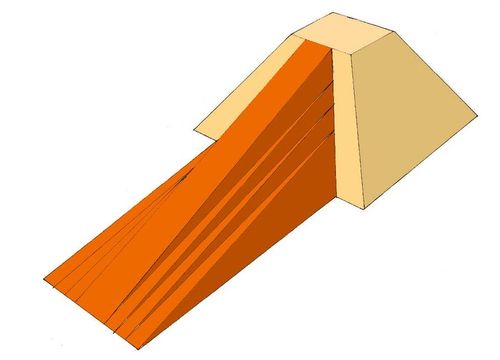
Front ramp
The frontal ramp is built on only one side of the pyramid. Of restricted width as the pyramid rises, it is also more and more steep, which complicates the task of the workers going up the blocks.
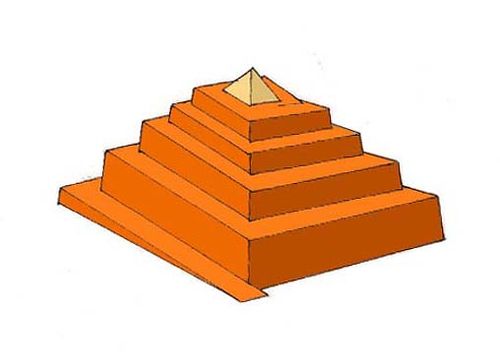
Wraparound ramp
The principle of the enveloping ramp is simple, it consists of having only one ramp that rotates at right angles to each stop of the pyramid. The higher you go, the longer the pyramid. Such a ramp is complex to implement, but it has the advantage of having a regular slope. On the other hand, it imposes the transport of loads over long distances.
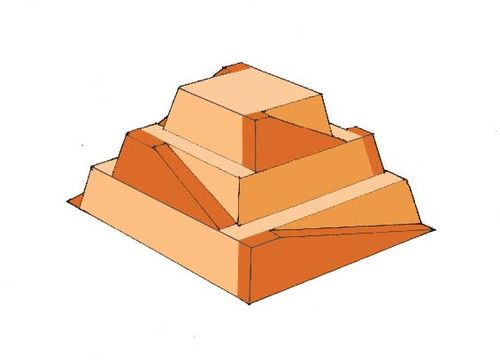
Side ramps
The side ramps are a succession of small ramps along the 4 sides of the pyramid to build. This type of ramp is easy to build and maintain.
Other types of ramps have been proposed, but it is a mixture of these three possibilities: The Egyptians of the time could have built the pyramids with two frontal ramps, one in use while the other is raised, the time that the workers finish the level and they can continue with the 2nd ramp, the first being at that moment also raised. Another attempt at explanation consists of a frontal ramp rising to one third of the height before continuing in the form of a helical ramp.
The method of internal ramp is very original, it is recent. It is supported by the French archaeologist Jean-Pierre Houdin and consists of moving the blocks up an internal gallery. The latter would run behind each face a few meters, and climb gently to the floor under construction. If this hypothesis seems at first far-fetched, it is not only very serious but partly verified by the internal temperature records of the pyramid. These readings show a temperature difference of the stones that follow an internal spiral trace, from bottom to top. It is therefore quite possible that a spiral gallery existed before it was filled.
The last method is silting. The idea is that once several stages are assembled, the main winds of the Giza plateau are expected to sow the work, which forms a natural ramp. This silting could also have been done artificially, by moving the sand on the side of the pyramid. The main problem of this technique is that it does not allow to make a pyramid as high as that of Khufu, sanding should have been done several hundred meters for that, which is unlikely.
Learn more about the building pyramids.
Downgrades
Of course, with an existence of XXVII centuries, the pyramid of Khufu suffered degradations, whether natural or artificial.
Externally, it is the natural degradations that have done the most damage. The time gradually fragmented the stones of the siding, showing the pyramid as it was before its cover. But it was the earthquake of the fourteenth century that was the most terrible. Indeed, it was during the fourteenth century that there was a gigantic earthquake that shook all lands around the Mediterranean. It caused great damage everywhere. It was this earthquake that permanently put down the Alexandria lighthouse, one of the seven wonders of the world, for example. This trembling caused a great part of the limestone cladding to fall to the ground. Easily available, these stones were then used to build the houses of a new city that was to replace those collapsed by this natural disaster: Cairo. This is the origin of the Egyptian capital, and unfortunately, that of the end of the cladding of the Great Pyramid of Khufu.
Nowadays there are some of these stones near the ground in some places, which allows us to imagine how it was at the end of its construction. These stones come from an underground quarry in Tourah, east of Cairo. They extracted fine white limestone that was easy to work with.
The neighboring pyramid of Khafra retains some of its Tourah stone cover on its summit. But the best example of this type of cover is on the rhomboidal pyramid, which retains it almost entirely.
The superstructure has also been damaged by other means. First of all, it has lost its summit, which is nowadays a flat platform of about 100m2. Then, many stones were degraded by tourism, at a time when it was not protected. Casement, it is not very long since we take into account the degradation suffered by the monuments due to tourism, and on a site like that of Giza, very known, these degradations were multiple: loosening of stones, falls of small stones, burning in the stone of names, dates, etc.
Internally there is no real natural damage, the galleries have been well preserved. On the other hand, the biggest degradation made to the pyramid of Khufu is the sultan's gallery, which was pierced by the stone. It was made to find rooms filled with treasures but only led to the descent to the underground hall. If we compare this breakthrough to what was done for the pyramid of Djoser, we are there on a treasure (since this pyramid was dug many galleries), but it's still important to note it.
Finally, it should be known that the pyramid of Khufu was surmounted by a pyramidion, a kind of terminus richly decorated. Unfortunately, we have no trace of it today.






